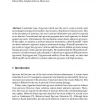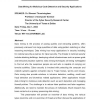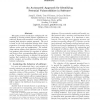60 search results - page 8 / 12 » Detecting Anomalous and Unknown Intrusions Against Programs |
SEC
2008
13 years 9 months ago
2008
A particular type of spyware which uses the user's events covertly, such as keyloggers and password stealers, has become a big threat to Internet users. Due to the prevalence ...
WEBI
2009
Springer
14 years 2 months ago
2009
Springer
: Data mining is the process of posing queries and extracting patterns, often previously unknown from large quantities of data using pattern matching or other reasoning techniques....
CCS
2007
ACM
14 years 1 months ago
2007
ACM
To ameliorate the quality of protection provided by intrusion detection systems (IDS) we strongly need more effective evaluation and testing procedures. Evaluating an IDS against ...
OOPSLA
2007
Springer
14 years 1 months ago
2007
Springer
Calling context enhances program understanding and dynamic analyses by providing a rich representation of program location. Compared to imperative programs, objectoriented program...
SP
1998
IEEE
13 years 11 months ago
1998
IEEE
This paper presents results from analyzing the vulnerability of security-critical software applications to malicious threats and anomalous events using an automated fault injectio...



